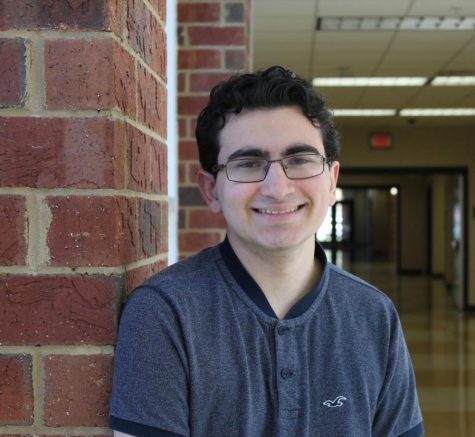Returning or Remote: How Are Students Adapting To New Academic Obstacles?
November 18, 2020
Buses turn into the parking lot and students pour into the building. The hallways and classrooms buzz with discussion, and freshmen, seniors and everyone in between make the trek to their first period.
Miles away, students stumble out of bed. An observer might say they’re unprepared for school, but as they fire up their phones and computers, they’re perfectly ready. These students won’t be trekking anywhere; school comes to them.
These two scenes are each student’s option. After having universal online school for the first five weeks of the academic year, the school and county gave students the choice to return to school, starting full time on Oct. 14, or to remain virtual.
On that day, according to 71% of students, or 1,460 students, decided to move to in-person, while 29%, or 580, remained virtual.
These figures fluctuate over time, however, and as of the week of Nov. 1, only 56% of the school’s students are attending school in person.
At a Fulton County Schools board meeting Tuesday, officials said approximately half the district’s students are face-to-face while the other half is online, the Atlanta Journal Constitution reported.
At Cambridge, senior Alexander Feskanin was among those who returned, and for him, it was hardly a choice.
“I always knew I would choose to go back to school, mainly because of the human interaction,” he said.
The desire to interact with others, rather than remain in a mostly isolated and disconnected virtual setting, proved the largest factor for Feskanin. As some have said, initials on a Teams meeting do not work as a substitute for faces, or in Feskanin’s words, “It’s better to interact with people than to stare at a screen all day.”
For senior Audrey Kittila, meanwhile, safety is the number one concern. While the school may be reopening, the threat posed by COVID-19 is not gone.
Even so, Kittila decided to return, saying the school has done well ensuring the safety of students and staff. The school’s various health measures, including universal masking and social distancing, were enough to ease her fears about the virus. She acknowledged, however, that others may not feel quite as comfortable returning.
Freshman Jackson Fardo, in contrast to Feskanin and Kittila, made the opposite decision, and is staying virtual for the remainder of the semester.
While Fardo said it is likely true he learns more efficiently in a classroom setting, with possible benefits such as less distractions and stronger connections with others, his choice was dictated by a single factor: the need for time, specifically, the time he saves at the beginning and end of the school day, which usually would have been used for going to and from the building.
Fardo said this was essentially the sole motivation for remaining online, and the time is largely being put towards his position as a football player.
Once the semester and football are over in the spring, Fardo said he will be fully willing to return to school.
He also said the three-day shutdown during the week of Oct. 19 was something of a vindication of his decision to remain. While time is still the main factor, not having to flip back and forth between settings, as COVID-19 remains a danger in schools, is a positive to having chosen virtual school.
The one change Fardo said he noticed was the priorities of teachers, who now place greater focus on in-person students, which Fardo, despite the disadvantage to himself, finds understandable.
Teachers can more easily speak and connect with students in-person, allowing for more attention to be placed there. In contrast, “[for] the kids they have online, they can’t do much but sit behind a computer screen and tell them what to do,” Fardo said.
Feskanin said his ability to learn markedly increased with the return to a classroom setting. The human connection, he said, is a main part of learning, and it is better achieved face-to-face as opposed to a chatroom where most people have their cameras and microphones off.
Science teacher James Seals, meanwhile, comments on how his class is run in-person versus virtually, the answer being: not very differently.
Seals said his classes, even before the pandemic, were suited to something like online learning. They would involve a lecture on the topic at hand before students would complete review questions. This setup functions both in-person and virtually, with little need for modification.
The one major difference is how far Seals would go with his content. In prior years, and in in-person classes now, should he or the students wish to, it was possible to go into advanced topics, ones not on the curriculum but taught for the sake of interest or fun.
Being able to check in on face-to-face students and easily communicate with them made this feasible, which has been stripped away by virtual school.
While the shift to in-person school may have been difficult for both faculty and students, the school population can be said to be doing well at one thing: following health guidelines.
Seals, Kittila and Feskanin all said that, at least from what they’ve seen, students have been very consistent and cooperative with following the rules set out by the county and school. While wearing masks has been a non-issue, social distancing protocols are somewhat more of a difficulty.
Sitting in distanced seats is one thing, but trying to stay far apart in crowded halls is another, though at minimum, nobody has mentioned any instances of intentional violation of guidelines.
School and education has been a fixture of many young people’s lives since they can remember, and despite the incredible circumstances it now faces, it shows no signs of letting up.
While it may require serious and radical changes to adapt, it seems more than willing to make those shifts, dragging everyone else along with it, for better or for worse.
